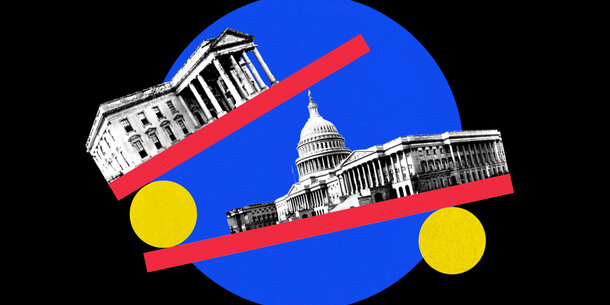During four years in public housing in Cairo, Illinois, Earlene Lyons lived with roach infestations and experienced three spontaneous kitchen fires due to faulty wiring. According to reporting by ProPublica, her neighbors suffered through “inoperable heat, leaky ceilings, broken windows, mold, mice, roaches, and frequently clogged toilets and sinks.” In the end, rather than fix the crumbling Illinois complex, the Department of Housing and Urban Development closed it, forcing residents to uproot themselves and their children. “It’s a betrayal, really,” Lyons told a reporter.
If what happened to Earlene Lyons was a betrayal, the fault goes beyond the administrators at the housing department. For years, U.S. federal agencies have operated under immense strain. Underfunding has starved them of the resources necessary for adequate staffing, modern technology, and effective service delivery. Hiring freezes have stunted recruitment, and three in ten federal workers are nearing retirement, leaving agencies dependent on an uncertain pipeline of incoming workers.
A Brennan Center analysis of federal data finds that employee numbers in key cabinet-level agencies such as the Departments of Housing and Urban Development, Treasury, Interior, Energy, and Agriculture have dropped precipitously in the past decade. Employee numbers have also plunged at independent agencies like the Environmental Protection Agency and the Social Security Administration.
The results are being felt not only in public housing complexes in Illinois, but also on Nebraska farms, in communities abutting chemical plants in Louisiana, and in countless other locales across the country.
The Biden administration released its budget for fiscal year 2024 in March, signaling that it wants to substantially increase support to federal agencies, invest in recruitment, and add 82,000 employees to the federal workforce. But with the funding proposal facing instant pushback from Republicans, lawmakers in Congress are not on a path to redressing the hollowing out of core agencies and solving this underappreciated generational challenge.
A dozen years of attrition
In 2011, the Republican-led Congress and the Obama administration agreed to sweeping budget caps known as sequestration. The resulting hiring freezes and downsizing largely executed between 2013 and 2017 took a heavy toll on federal agencies.
During his 2016 campaign, Donald Trump pledged to shrink the federal executive branch and “cut so much your head will spin.” While some agencies focused on security and defense grew during Trump’s presidency, federal employee numbers tumbled further at most cabinet-level agencies, with particularly dramatic drops at the Departments of Interior, Labor, Justice, State, Agriculture, and Health and Human Services.
As a result of the sequestration and the Trump-era zeal for cuts, most cabinet agencies today have fewer federal employees than they did in 2010. Those drops are particularly stark at some key agencies, according to the Brennan Center’s analysis of data from the U.S. Office of Personnel Management between September 2010 and December 2022. Despite the centrality of food and farming to people and politics, the Department of Agriculture had 22,526 fewer federal employees at the end of 2022 than it did in 2010, according to the latest available data, a 21 percent drop in federal employee numbers over twelve years. The Interior Department, which oversees the bulk of the nation’s public lands, had 18,468 fewer federal employees than it did in 2010 — a 23 percent decline — and the Treasury Department, which manages the country’s finances, had 10,931 fewer federal employees, a 10 percent reduction from 2010.
While the Biden administration has taken steps to improve matters, many federal agencies continue to suffer from the squeeze. A steady drumbeat of across-the-board hiring freezes and periodic government shutdowns has reduced agencies’ efficiency and effectiveness.
The problem is even worse than the raw numbers suggest — with staff attrition came lost expertise and experience. In 2019, the Trump administration abruptly moved two research agencies in the Department of Agriculture from Washington, DC, to Kansas City without adequate vetting or considering estimated staff attrition rates. The relocation gutted the department’s Economic Research Service and National Institute of Food and Agriculture: most employees left after the announcement of the move. Though the Biden administration has largely built up the agencies’ workforce, it is now made up of “mostly recent hires with significantly less experience than the previous workforce,” according to the Government Accountability Office. Diversity has also suffered. Following the poorly vetted relocation, the number of Black employees shrank by half from 2018 to 2021.
Federal data shows that the Biden administration has largely boosted employee numbers over the levels recorded in September 2020. But according to the Brennan Center’s analysis of federal personnel reports from December 2022, the administration failed to replenish employee numbers to pre–Trump administration levels in agencies including the Departments of Interior, Labor, Justice, Agriculture, and Transportation.
Vacancies in political positions also persist, creating leadership vacuums that make it harder to implement programs. There are 93 positions still without a Biden nominee, and 91 of his nominees are being considered by the Senate, according to a tracker by the Partnership for Public Service and the Washington Post. Biden has filled positions more quickly than Trump but more slowly than President Barack Obama. Partisan obstructionism and arcane Senate confirmation rules impede the process.
A hollow federal government in a time of rising challenges
Even as agencies grapple with less staff and diminished expertise, their responsibilities have expanded substantially. The U.S. population is more than twice what it was in 1950, while the size of the federal civilian workforce has remained relatively steady over the past half century. During that period, entirely new challenges — and problems that policymakers are newly attuned to — requiring government intervention emerged. The Environmental Protection Agency and the Departments of Energy, Agriculture, and Interior among others must help carry out Biden’s goal to halve greenhouse gas emissions this decade. The number of billion-dollar disasters in the United States has ticked steadily upward over the past 40 years. Numerous new federal assistance and grant programs in the Inflation Reduction Act and American Rescue Plan Act create more tasks for agencies that must administer them.
A review of individual agencies highlights how resource constraints prevent important government action. Within the next 18 months, the Environmental Protection Agency is being asked to write several major rules and regulations to outpace a possible change in administration or a new Congress. But a “traumatized” and overwhelmed staff — reeling from Trump’s governmental sledgehammer — has missed several self-imposed deadlines. The number of federal employees working for the agency has dropped by around 18 percent since 2010, before sequestration cuts took place, according to the Brennan Center’s analysis.
The EPA’s enforcement office has suffered from chronic underfunding and stagnant income levels for a decade, contributing to a decades-long slump in enforcement. Last year, Biden’s EPA brought the lowest number of civil enforcement cases against polluters in the past two decades. This year, the agency received an added infusion of funds for enforcement and other tasks for the first time in years.
The Department of Housing and Urban Development has also floundered in the face of losing many of its highest-skilled managers and experts. The department is in the grip of an internal staffing and resource emergency. It lost 18 percent of its federal employees between September 2010 and December 2022, even as the U.S. population grew by 24.5 million. The housing department inspector general last year found that employees and constituents “consistently described [the housing department] as being underfunded and understaffed, with inadequate infrastructure to address the growing mission, program responsibilities, and mandates of the agency.” At a Senate hearing in mid-2021, Housing Secretary Marcia Fudge said she would not “sugarcoat” the agency’s struggles. “Until we can start to build up our staff, and build up our capacity, we are at risk of not doing the things we should do.”
Labor leaders last year said persistent underfunding of the National Labor Relations Board had reached a crisis point, even as labor organizing efforts have skyrocketed. In November, the board’s leadership told Congress that it would be forced to furlough staff without more funds. For the first time since 2014, the agency received an increased injection of cash in this year’s spending bill to fund government agencies. Lawmakers’ persistent use of continuing resolutions — stopgap measures that fund the government at prior levels — can disrupt agencies’ plans and slow down hiring across the board.
Staffers feel the mismatch between government size and mission acutely. Overall, just over 60 percent of federal agency employees reported having a reasonable workload last year. While engagement and satisfaction have grown for some agencies and agency offices in the past decade, others — such as the Social Security Administration and Justice Department — have seen engagement and satisfaction levels fall by more than ten points since 2010, according to scores by the Partnership for Public Service using the government’s viewpoint surveys.
Another source of stress for government agencies is the federal judiciary. The Supreme Court has dealt blows to the scope of agencies’ authority and could do so again. In an upcoming Supreme Court case, the justices will determine the constitutionality of the funding structure for the Consumer Financial Protection Bureau. The outcome could hobble the agency and put others in similar jeopardy. Two recent decisions attacked the leadership structure of financial regulatory agencies. And the Court struck down several recent agency regulations that would have responded to contemporary crises, from the pandemic to climate change, using a novel doctrine that requires express congressional authority for agency regulation concerning issues of “vast” economic or political significance. In this landscape, it is critical that the executive and legislative branches build up agency capacity rather than aid attacks on administrative authority by undermining agencies’ ability to perform at their best.
As agencies navigate myriad challenges in the 21st century, they are faced with a significant predicament: they must provide the sophisticated service delivery and swift action that allow the public to witness their value, while struggling under massive workloads and resource gaps. Major changes to how agencies operate, including how they hire, train, and allocate responsibilities, have not been made in decades.
It is clear that agencies need more support to continue to deliver critical services, engage in evidence-based policymaking, and meet contemporary challenges. Increased congressional appropriations are essential to ensure that federal agencies have the personnel and resources to carry out their statutory missions. It is also vital that agencies be led by qualified, dedicated public servants. And building on several Biden administration initiatives, both the executive branch and Congress must establish safeguards against abuses of power that have damaged morale and driven experts out of government service. Federal agencies serve the public and address national crises — protecting agencies’ ability to fulfill their missions is crucial to a well-functioning democracy.



